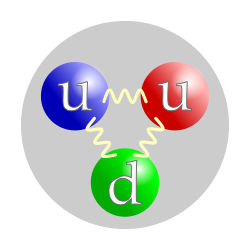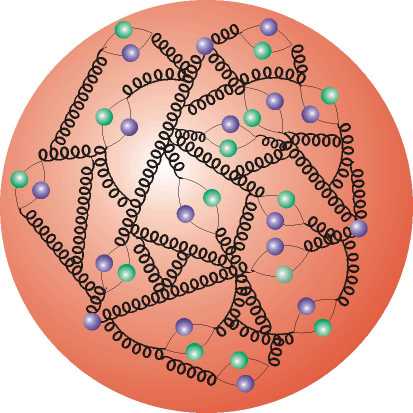 You’ve probably heard a thousand times that a Proton is made up of three Quarks: Two Up-Quarks and one Down-Quark. Right?
You’ve probably heard a thousand times that a Proton is made up of three Quarks: Two Up-Quarks and one Down-Quark. Right?
So lets just take a quick look to see how they add up.
OK – an Up Quark weighs in at 1.8 to 3.0 MeV/c2 — Million Electron Volts divided by the speed of light squared. That is its “rest-mass.”
and a Down-Quark weighs in at 4.5-5.3 (MeV/c2)
So Two Up Quarks ~ 3.6 to 6.0 MeV/c2
Added to One Down Quark ~ 4.5 to 5.3 MeV/c2
Total ~ 8.1 to 11.3 MeV/c2
Now a Proton weighs in at 938 MeV/c2.
Whoa ! That doesn’t add up. This means a Proton is more than 83 times heavier that the three quarks !

Scale UnBalanced
Wait a minute. Lets try that again with the new values calculated by Lattice Quantum ChromoDynamics —
4.0 MeV (two Up Quarks)
+ 4.8 MeV(one Down Quark)
________
= 938 MeV
No – it still doesn’t add up. They only reach a maximum of about 8.9 MeV.
What’s going on here?
Well, thanks to Prof Matt Strassler and Adrian Cho we find out that we’ve been fed a bit of a whopper – and not the fast food kind.
According to Prof Strassler (who makes lots of sense in his other particle physics articles) a proton is made up of “zillions (meaning “too many and too changeable to count usefully”) of lightweight particles called quarks, antiquarks and gluons.”

Proton “Dance Floor” – Quarks (purple), antiquarks (green), and gluons (squiggles) — (Credit: Deutsches Elektronen-Synchrotron – DESY)
Wow. That stopped me in my tracks the first time I read it. This is stunning and exciting.
Except for the “it’s highly disorganized” I’m willing to try this out.
Let me respectfully suggest that because every proton acts identically (every proton from your fingernail to far reaches of the Universe) and never decays, that proton component particles are not just organized, but perfectly choreographed. Meaning there ARE solutions to the Three-body and N-body problems – We just haven’t found them yet!
Apparently the three original quarks are “valence” quarks and the remaining quarks are “virtual.”
Its still stuns me that there are so many more tinier things zooming around inside a proton; a particle I was taught was almost fundamental just a short while ago.
Wikipedia reports:
“The remainder of the proton mass is due to the kinetic energy of the quarks and to the energy of the gluon fields that bind the quarks together.“
What does that mean? That makes me wonder – How can binding energy turn into kinetic energy? Aren’t they opposites? and Does this mean a quark’s kinetic energy reduces with lower temperatures?
How intriguing that the humble proton could be made up of so much more amazing structure that we have yet to discern. I’m wondering how the Particle Standard Model predicts this . . .
What do you think of this?
The only other remaining mystery is why CERN or DESY hasn’t snagged Prof Strassler yet. He has an extraordinary ability, and a keen interest, in making complex particle physics ideas clear (and even fun) for the rest of us. (and No, I have no affiliation with Prof Strassler, and you should not imply that he endorses my opinions.)
Related articles:


Pingback: Electron No Longer a Fundamental Particle | Cosmology Science © 2011-2013 David Dilworth
The problem is slightly different, the naive algebra is meaningless since the quarks as well as gluons have no rest masses. Contrary to electron or the proton, nobody can measure their rest masses as they do not propagate as a free particles. The values quoted in this web site are defined at the renormalization scale of few GeV, say ~ 2GeV. Note, the so called quark mass function varies with momentum…. The explanation of proton mass in terms of any constant quark masses is very naive and impossible as is well known for many decades. Related phenomena is known under the name “dynamical mass generation” or chiral symmetry breaking, which are relatively well understand in terms of QCD Greens functions -the serious subject of interest http://www.uv.es/qcdtnt/, http://teorica.fis.ucm.es/Confinement9/, etc. etc. …
Thank you Vlad. The idea that the quark rest-mass is not measurable makes some sense.
Pingback: Are all ground state protons the exact same mass and have the same number of elementary particles? | Question and Answer
Shouldn’t the masses you mention be MeV/c^2, that is divided by the speed of light squared, as opposed to c?
Yes David, I believe your suggestion is correct.
Please try to forgive my omission.
I have corrected the text and updated it with the newest values of Up and Down quark “weights.”
Thank you.
Quarks and gluons are making the wortex of quantum vacuum which additionally diminishes energy density of quantum vacuum which carries mass of particles